Michigan grape scouting report – Aug. 19, 2020
Most grapes have completed or are starting veraison. Grape berry moth and downy mildew incidents are increasing.

Weather
Last week was warmer. Most days saw highs in the mid-80s and lows in the 60s. A storm system passed on Sunday, Aug. 16, that dropped isolated heavy rain in portions of eastern Michigan. Unfortunately, most grape growing regions were completely missed. This week will be a little cooler, with highs near 80. The best chance of rain is on Sunday/Monday.
With the warmer week, we picked up more growing degree days (GDD) last week than the week before: 150 GDD base 50. The southwest region is 425 GDD base 50 ahead of the northwest region.
|
Northwest Michigan GDD summary from March 1 – Aug. 17, 2020 | ||
|---|---|---|
|
Northwest stations |
GDD 50 F |
GDD 47F from wild bloom (grape berry moth model) |
|
Petoskey (Petoskey) |
1564 |
1403 |
|
Traverse City (NWMHRC) |
1710 |
1549 |
|
Old Mission (Old Mission) |
1651 |
1478 |
|
Avg for NW region |
1651 |
|
|
Average last week |
1505 |
|
|
Southern stations |
GDD 50 F |
GDD 47F from wild bloom (grape berry moth model) |
|
Benton Harbor (SWMREC) |
2128 |
1969 |
|
Lawton (Lawton) |
2088 |
1885 |
|
Fennville (TNRC) |
1936 |
1770 |
|
Avg for SW region |
2077 |
|
|
Avg last week |
1926 |
|
|
Romeo (Romeo) |
2012 |
1827 |
|
Avg for SE region |
2022 |
|
|
Avg last week |
1871 |
|
Note: Wild grape bloom dates are estimates. See “Mid-season management of grape berry moth” for bloom dates.
Vine growth
Statewide, most hybrids and vinifera grapes are completing veraison in the southwest and starting veraison in the northwest. Concords have just started in some sites in the southwest. Berries are close to full size. Some varieties are beginning to soften, acid levels are starting to drop, and the earliest table grape cultivars are soon to be harvested. Many growers have completed cluster zone mechanical or manual leaf removal, shoot positioning, and hedging in vinifera varieties.

Crop adjustment work is underway, both mechanically using harvesters in juice grape vineyards and by hand in wine grape vineyards. The Michigan State University Extension bulletin “Predicting Harvest Yield in Juice and Wine Grape Vineyards (E3186)” provides tools to reduce both annual yield and quality variability among years by aiming for improved vine balance (fruit to vegetative growth). The intensity of crop thinning depends on the cultivar and vine vigor.
Veraison is also the time to plan for “green drop” to ensure the highest quality harvest for any specific cultivar. This technique reduces variability in fruit ripening by removing “green” fruit that are behind in maturation (selected at late veraison stage) so that uniform ripeness can be achieved at harvest for optimal wine quality. Growers or their vineyard workers can scout for clusters that are unlikely to ripen, and remove them from the vine. Those clusters are usually green, in the wrong position in the canopy, or starting to show signs of infection.
The window of time for collecting petiole samples for nutrient analysis is over in the southwest region, but there is likely still time in other regions. The information from petiole samples for foliar tissue analysis can be used to identify deficiencies and plan ahead for nutrient inputs for next season.
|
Variety |
Northwest region (degrees Brix) |
Southwest region (degrees Brix) |
|---|---|---|
|
Pinot Noir |
10.7 |
-- |
|
Pinot gris |
12.9 |
-- |
|
Cabernet franc |
5.8 |
-- |
|
Zweigelt |
11.1 |
-- |
|
Riesling |
4.4 |
-- |
|
Madeleine Angevine |
13.2 |
-- |
|
Cabernet Sauvignon |
-- |
14.2 |
|
Sauvignon Blanc |
7.6 |
-- |
|
Merlot |
-- |
10.8 |
|
Traminette |
-- |
8.4 |
|
Valvin Muscat |
-- |
9.9 |
|
Marquette |
-- |
16.2 |
|
Seyval Blanc |
-- |
16.2 |
|
Concord |
-- |
7.7 |
|
Niagara |
-- |
9.3 |
Diseases
The disease focus for most grape growers around Michigan is still on downy mildew and powdery mildew management, but cluster rots are becoming more important as Brix levels increase. This week, some southwest vineyards with early ripening hybrids are seeing botrytis symptoms. The timing for sour rots is also approaching as berries begin to ripen.
At this time, we are most concerned about defoliation caused by downy mildew. This article provides more information on late season downy mildew control.

Opening up the grape canopy for air movement helps reduce powdery mildew and allows for better spray penetration. Shoot positioning and cluster zone leaf removal can also help. For more information on how weather conditions affect powdery mildew development, see: Why some seasons are worse for powdery mildew.
Several strategies contribute to good botrytis bunch rot management. These include opening up the canopy, properly applying fungicides and using resistant cultivars when possible. Good botrytis control depends on getting good coverage. Fungicide resistance management is also important. The most effective products for botrytis are site specific and prone to resistance development. A new Michigan Grape Fact Sheet is now available for Managing botrytis bunch rot for more information about the disease.
Sour rot can be particularly difficult to control on tight clustered varieties. Enhancing airflow through the canopy and clusters can help, so leaf pulling, thinning, shoot positioning and weed control can all provide some reduction in sour rot risk. Another important aspect of control is preventing berry damage (e.g., bird pecks, insect feeding and mechanical damage) to reduce the initiation of berry infections. Chemical control measures can also be used that combine an insecticide with a contact fungicide. In high risk cultivars (e.g., Vignoles) and in hot and humid conditions these treatments should be applied before symptom development and clusters have reach 13-15 degrees Brix. Under high disease scenarios, treatments should be applied on seven to 10 day intervals until harvest.
This is a good time to scout for suspicious issues related to other vine stressors. Many of these problems can be abiotic including nutrient related issues and graft incompatibility. But some of the biotic problems can be caused by grapevine trunk diseases or grapevine viruses. If you are interested in taking samples and testing, you can send them to MSU Plant & Pest Diagnostics. Please see these articles on grapevine trunk disease and sampling for grapevine viruses.
A complete list of grape fungicides can be found in the E154 Michigan Fruit Management Guide. Check the guide for potential phytotoxicity of certain sprays on Concord grapes especially. Phytotoxicity risk is higher with high temperatures and quickly growing vines. One important thing to remember at this time of year is to keep track of preharvest intervals for fungicides.
Insects
Grape berry moth damage continues to increase at the borders of many vineyards in southwest Michigan as the third generation infestation becomes visible. Growers with problems from grape berry moth last year should be scouting and protecting vines through this current third generation. In high pressure sites, one application is unlikely to be sufficient and we provide guidance in this article: August is key time for protecting clusters from grape berry moth.
Potato leafhoppers and grape leafhoppers have mostly been at low levels, but at some sites damage from these insects has been observed. Grape leafhopper feeds on juice grape leaves inside the canopies in the shade, so be sure to scout inside the canopy. Potato leafhopper causes yellowing and cupping on the leaves of susceptible wine grapes, so check under the leaves of vines with these symptoms for the small green insects.
As this warm season progresses and harvest approaches, it will be important to be looking out for spider mites, mealybugs, yellowjackets, and vinegar flies.

Related resources
- Michigan Grape Scouting Report – August 12, 2020
- Southwest Michigan Fruit Update – August 18, 2020
- East Michigan Fruit Update – August 18, 2020
- A Mobile Guide for Grape IPM Scouting in North Central and Eastern U.S.
- Managing grapevine leafroll disease
- Michigan pesticide applicators receive temporary emergency license extension
- Agriculture support labs still open for business, with modifications
- August is key time for protecting clusters from grape berry moth
- Late season downy mildew control
- Do you suspect grapevine trunk disease in your vineyard?



 Print
Print Email
Email


